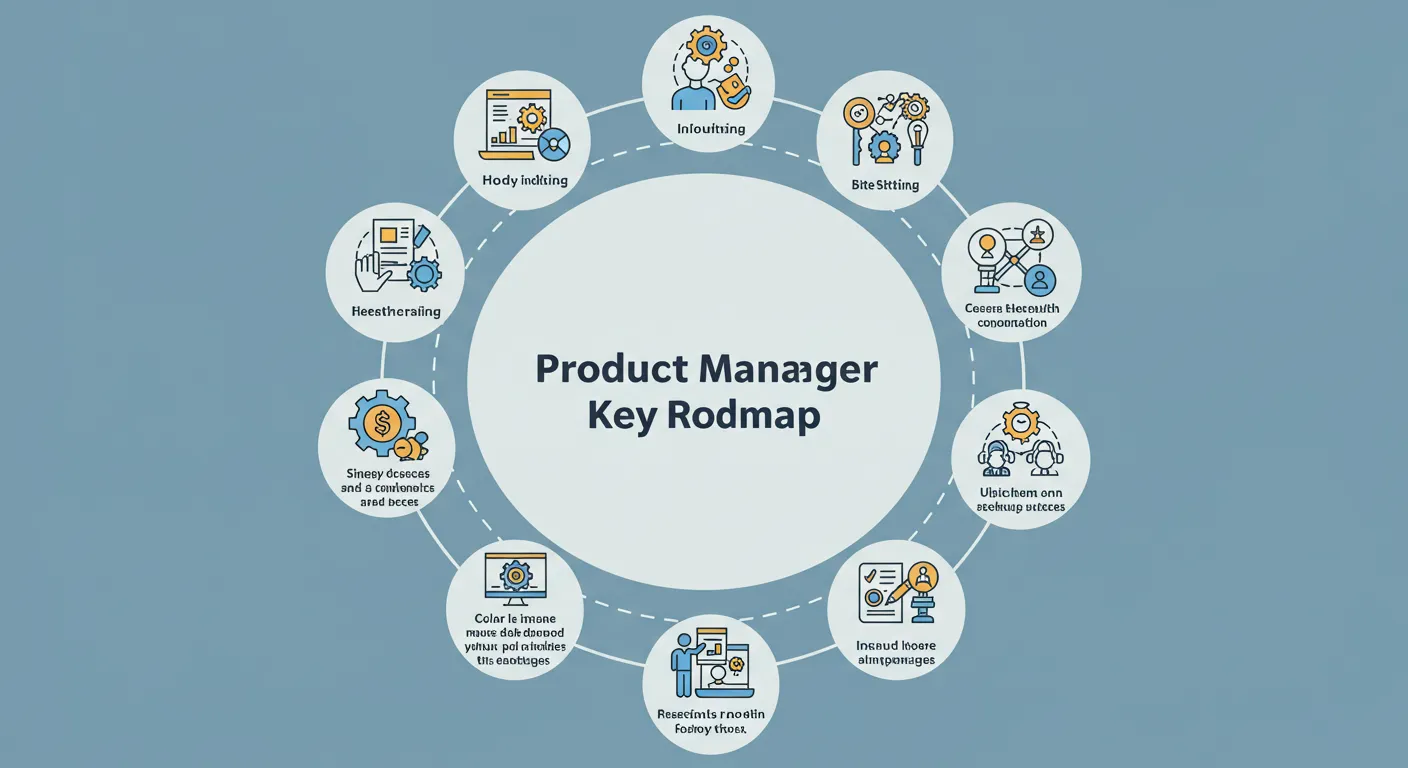Top 12 Product Manager Roadmap Key Pillars
Table of Contents
Product Manager Roadmap
1. Understanding the Role
- Fundamentals of product management
- Product management vs. project management
- The product manager’s role in the organization
- Various types of product managers
- Responsibilities and skills needed for a product manager
- Learning from successful product managers
- Building influential product manager qualities
2. Product Strategy
- Developing a product strategy
- Importance of product-market fit
- Working on competitive analysis
- Understanding market trends
- Prioritizing product initiatives
- Establishing product goals
3. Product Development Process
- Agile product development
- Lean product development
- Psychology within product development
- Designing for your target audience
- Iterative product development process
- Management and optimization of product life-cycle stages
4. Understanding Customer Needs
- Customer segmentation
- Understanding the customer journey
- Customer interviews
- Customer surveys
- Persona development
- Conducting focus groups
5. Using Product Metrics
- Important product metrics to track
- Analyzing product metrics
- Using metrics to drive product improvements
- Determining the success of a product
- Regular review of user behavior
- Metrics for growth hacking
6. Design and UX Principles
- Importance of UX in product management
- Wireframing
- User interface design principles
- Running A/B tests
- Using design systems and pattern libraries
- Collaborating with design teams
7. Technical Skills
- Understanding software development process
- Working knowledge of data analysis
- Rapid prototyping
- Working with APIs
- Database management and information systems
- Fundamentals of coding
8. Go-to-Market Strategy
- Building a go-to-market plan
- Pricing strategies
- Channel strategy
- Sales enablement
- Launch planning
- Partnerships and alliances
9. Leading Teams
- Effective communication within teams
- Leadership in product management
- Negotiating and influencing
- Conflict resolution
- Fostering creativity and innovation
- Building high-performance teams
10. Stakeholder Management
- Effective communication with stakeholders
- Negotiating with stakeholders
- Building relationships with key stakeholders
- Dealing with challenging stakeholders
- Presenting product metrics to stakeholders
- Managing stakeholder expectations
11. Risk Management
- Identifying risks in product management
- Prioritizing and managing risks
- Proactive risk management strategies
- Implementing risk mitigation plans
- Post-mortem analysis and lessons learned
- Regular risk assessment
12. Continuous Learning and Development
- Attending product management workshops and seminars
- Learning from industry leaders
- Participating in online product management communities
- Reading the latest product management books and articles
- Continuous improvement of product management skills
- Exploring product management certifications
1. What is the purpose of this Product Manager Roadmap?
This roadmap provides a structured guide to the key skills, knowledge areas, and responsibilities required for a successful career in product management. It helps aspiring and current product managers understand what to focus on at different stages of their journey.
2. Is this roadmap suitable for beginners?
Yes! This roadmap covers everything from fundamental product management concepts to advanced skills like stakeholder management and go-to-market strategies. Beginners can start with “Understanding the Role” and gradually progress to more complex areas.
3. Do I need technical skills to become a product manager?
While not all product management roles require deep technical knowledge, understanding software development, APIs, and data analysis can be valuable, especially in tech-driven companies. The Technical Skills section in this roadmap provides guidance on what’s essential.
4. How can I develop my product strategy skills?
You can improve your product strategy skills by:
- Studying market trends and competitor analysis
- Learning about product-market fit
- Understanding how to prioritize product initiatives
- Setting clear product goals
- Experimenting with real-world product decisions through case studies
5. What are the most important product metrics to track?
The Using Product Metrics section outlines key areas such as:
- User engagement metrics (e.g., DAU, MAU, retention rates)
- Conversion rates
- Revenue and profitability metrics
- Growth hacking KPIs
- A/B testing results
6. How can I improve my UX and design knowledge as a product manager?
- Learn about wireframing and prototyping tools like Figma or Sketch
- Study user interface (UI) design principles
- Understand A/B testing and user behavior analytics
- Collaborate with UX designers to improve product usability
7. What is the difference between product management and project management?
- Product Management focuses on defining product vision, strategy, and customer needs.
- Project Management ensures that tasks, timelines, and deliverables are completed efficiently.
While both roles involve coordination, a product manager prioritizes the “what” and “why” of a product, while a project manager focuses on the “how” and “when.”
8. How do I manage stakeholders effectively?
- Maintain clear communication with stakeholders
- Set realistic expectations and provide data-driven updates
- Negotiate effectively and handle challenging stakeholders
- Use metrics to justify product decisions
9. What are some common challenges in product management?
- Balancing business goals with customer needs
- Handling competing priorities and limited resources
- Managing stakeholder expectations
- Navigating technical and non-technical teams
- Ensuring successful product launches
10. How can I continuously improve my product management skills?
- Attend workshops, webinars, and industry conferences
- Read books and blogs on product management
- Join online communities and learn from experienced product managers
- Work on real or side projects to apply product management concepts
11. How long does it take to become a proficient product manager?
The timeline varies based on prior experience and learning pace. Some enter product management through business, marketing, or engineering backgrounds, while others transition from related roles. On average, 1-3 years of hands-on experience is needed to become proficient, but continuous learning is key.
12. Do I need a certification to become a product manager?
Certifications are not mandatory, but they can be helpful in learning structured product management methodologies. Some popular certifications include:
- Certified Scrum Product Owner (CSPO)
- Pragmatic Institute Product Management Certification
- Google’s APM Program






